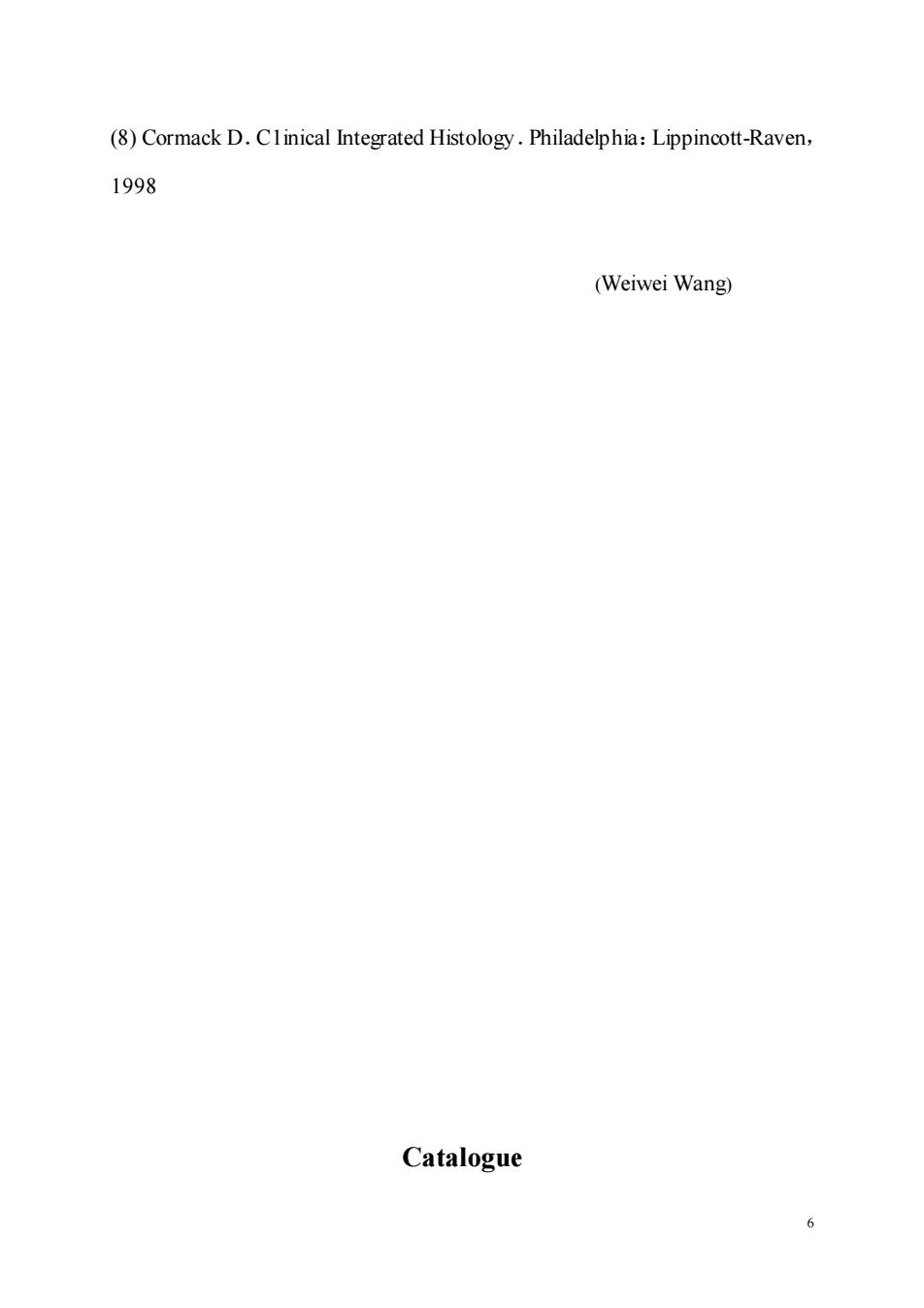
(8)Cormack D.Clinical Integrated Histology.Philadelphia:Lippincott-Raven 1998 (Weiwei Wang) Catalogue
6 (8) Cormack D.C1inical Integrated Histology.Philadelphia:Lippincott-Raven, 1998 (Weiwei Wang) Catalogue
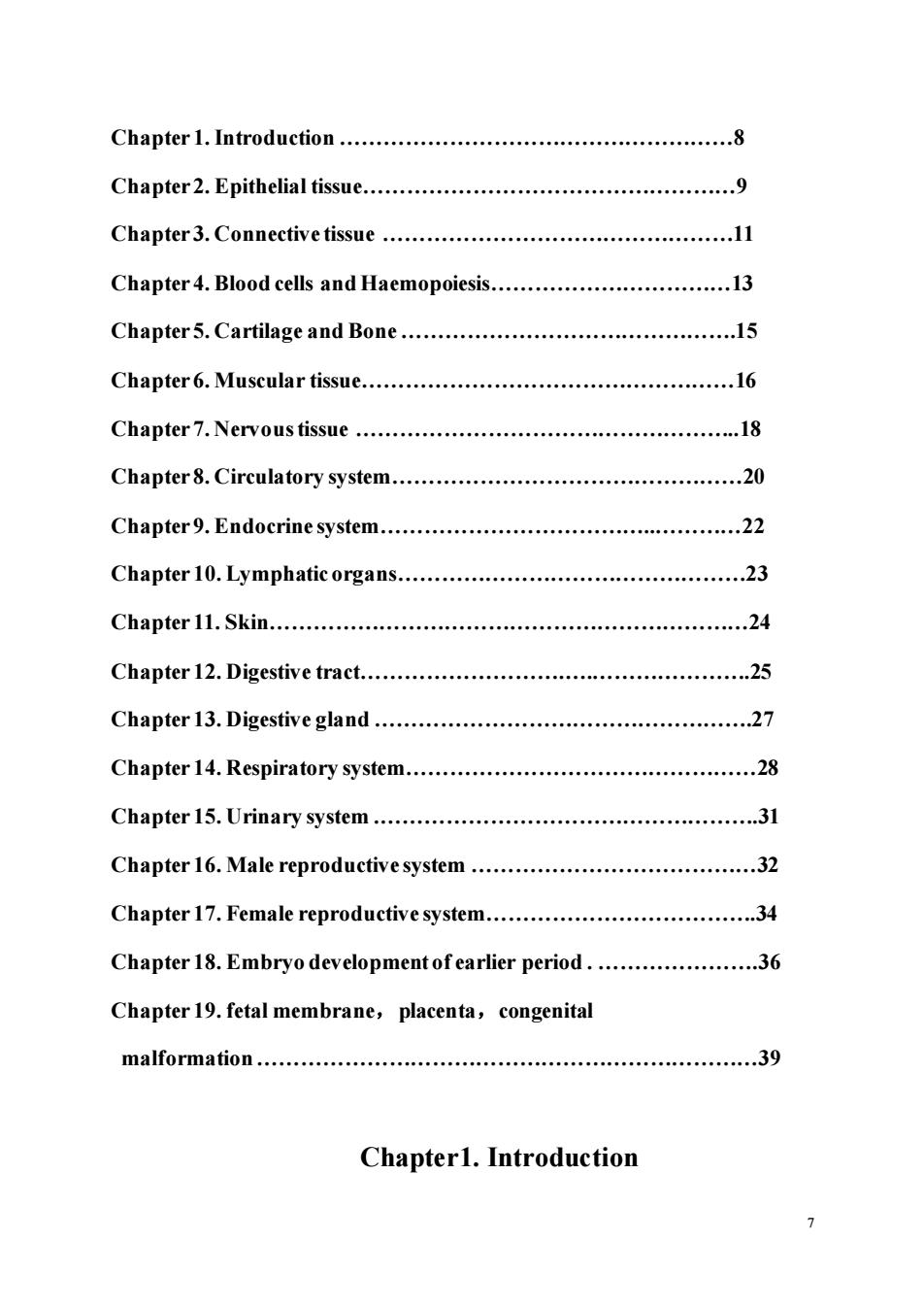
Chapter 1.Introduction.8 Chapter2.Epithelial tissue.9 Chapter3.Connective tissue. 11 Chapter4.Blood cells and Haemopoiesis.13 Chapter5.Cartilage and Bone.15 Chapter6.Muscular tissue.16 Chapter7.Nervoustissue.18 Chapter8.Circulatory system.20 Chapter9.Endocrinesystem Chapter 10.Lymphatic organs.23 Chapter 11.Skin. .24 Chapter 12.Digestive tract.5 Chapter 13.Digestive gland.27 Chapter 14.Respiratory system. Chapter 15.Urinary system.3 Chapter 16.Male reproductivesystem.32 Chapter 17.Female reproductive system. Chapter18.Embryo development ofearlier period.36 Chapter 19.fetal membrane,placenta,congenital malformation.39 Chapter1.Introduction
7 Chapter 1. Introduction .8 Chapter 2. Epithelial tissue.9 Chapter 3. Connective tissue .11 Chapter 4. Blood cells and Haemopoiesis.13 Chapter 5. Cartilage and Bone.15 Chapter 6. Muscular tissue.16 Chapter 7. Nervous tissue .18 Chapter 8. Circulatory system.20 Chapter 9. Endocrine system.22 Chapter 10. Lymphatic organs.23 Chapter 11. Skin.24 Chapter 12. Digestive tract.25 Chapter 13. Digestive gland .27 Chapter 14. Respiratory system.28 Chapter 15. Urinary system .31 Chapter 16. Male reproductive system .32 Chapter 17. Female reproductive system.34 Chapter 18. Embryo development of earlier period . .36 Chapter 19. fetal membrane,placenta,congenital malformation.39 Chapter1. Introduction
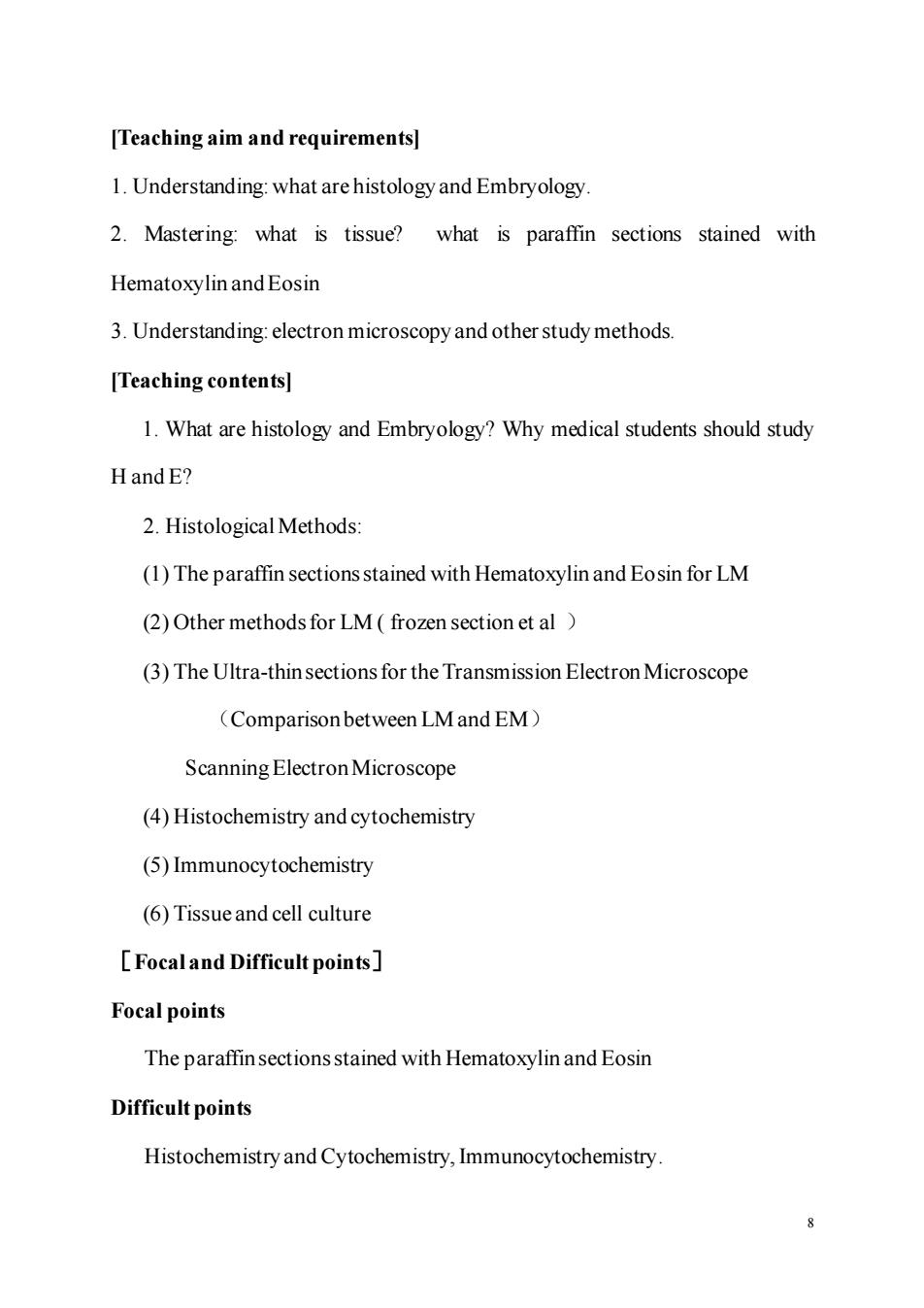
[Teaching aim and requirements] 1.Understanding:what are histology and Embryology. 2.Mastering:what is tissue?what is paraffin sections stained with Hematoxylin and Eosin 3.Understanding:electron microscopy and other study methods. [Teaching contents] 1.What are histology and Embryology?Why medical students should study HandE? 2.Histological Methods (1)The paraffin sectionsstained with Hematoxylin and Eosin for LM (2)Other methods for LM(frozen section et al (3)The Ultra-thinsections for the Transmission Electron Microscope (Comparison between LM and EM) Scanning Electron Microscope (4)Histochemistry and cytochemistry (5)Immunocytochemistry (6)Tissueand cell culture Focal and Difficult points] Focal points The paraffinsections stained with Hematoxylin and Eosin Difficult points Histochemistry and Cytochemistry,Immunocytochemistry
8 [Teaching aim and requirements] 1. Understanding: what are histology and Embryology. 2. Mastering: what is tissue? what is paraffin sections stained with Hematoxylin and Eosin 3. Understanding: electron microscopy and other study methods. [Teaching contents] 1. What are histology and Embryology? Why medical students should study H and E? 2. Histological Methods: (1) The paraffin sections stained with Hematoxylin and Eosin for LM (2) Other methods for LM ( frozen section et al ) (3) The Ultra-thin sections for the Transmission Electron Microscope (Comparison between LM and EM) Scanning Electron Microscope (4) Histochemistry and cytochemistry (5) Immunocytochemistry (6) Tissue and cell culture [Focal and Difficult points] Focal points The paraffin sections stained with Hematoxylin and Eosin Difficult points Histochemistry and Cytochemistry, Immunocytochemistry
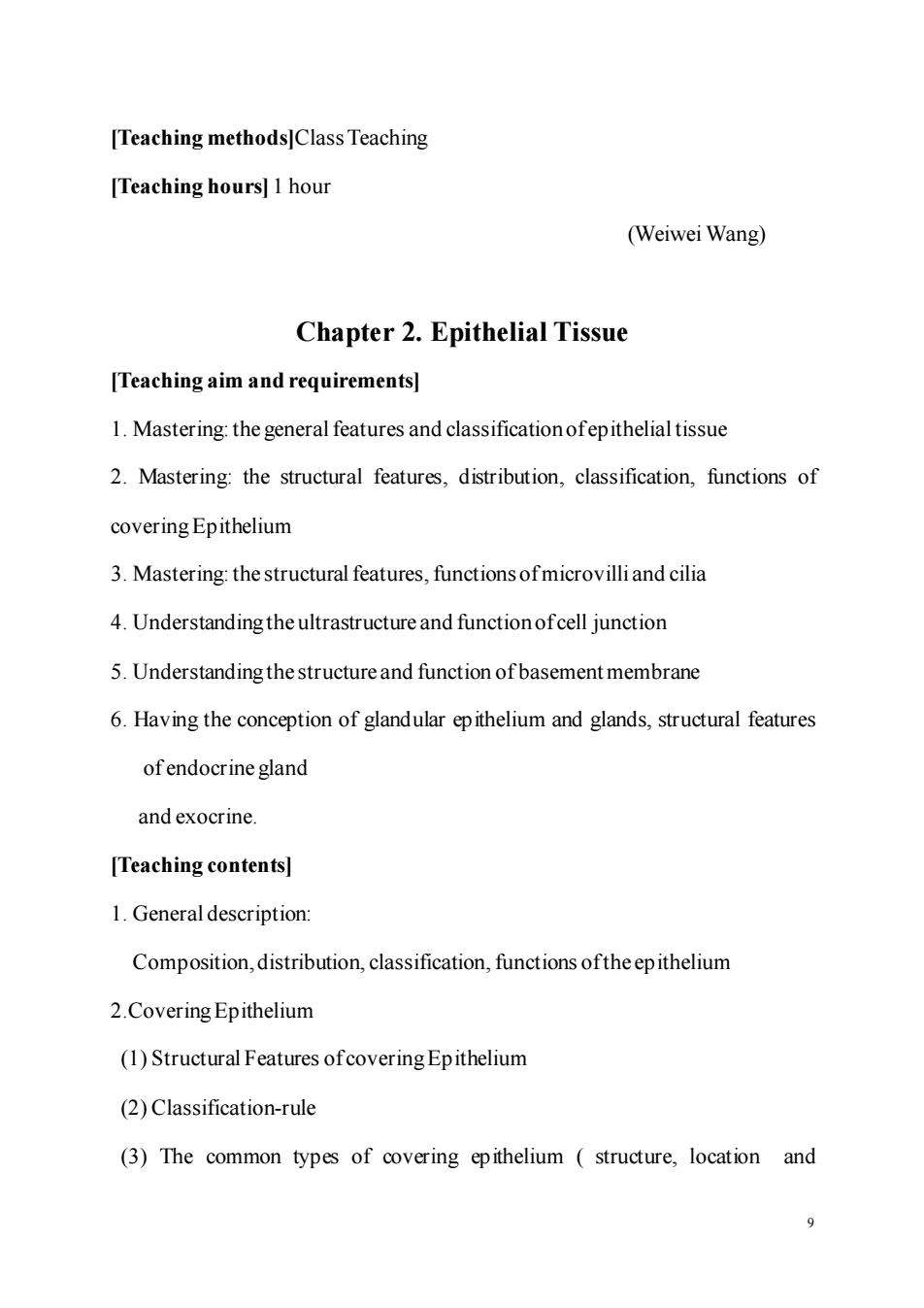
[Teaching methods]Class Teaching [Teaching hours]1 hour (Weiwei Wang) Chapter 2.Epithelial Tissue [Teaching aim and requirements] 1.Mastering:the general features and classificationofepithelial tissue 2.Mastering:the structural features,distribution,classification,functions of covering Epithelium 3.Mastering:the structural features,functions ofmicrovilliand cilia 4.Understanding the ultrastructure and functionofcell junction 5.Understanding thestructure and function ofbasement membrane 6.Having the conception of glandular epithelium and glands,structural features of endocrine gland and exocrine [Teaching contents] 1.General description: Composition,distribution,classification,functions oftheepithelium 2.Covering Epithelium (1)Structural Features ofcovering Epithelium (2)Classification-rule (3)The common types of covering epithelium structure,location and
9 [Teaching methods]Class Teaching [Teaching hours] 1 hour (Weiwei Wang) Chapter 2. Epithelial Tissue [Teaching aim and requirements] 1. Mastering: the general features and classification of epithelial tissue 2. Mastering: the structural features, distribution, classification, functions of covering Epithelium 3. Mastering: the structural features, functions of microvilli and cilia 4. Understanding the ultrastructure and function of cell junction 5. Understanding the structure and function of basement membrane 6. Having the conception of glandular epithelium and glands, structural features of endocrine gland and exocrine. [Teaching contents] 1. General description: Composition, distribution, classification, functions of the epithelium 2.Covering Epithelium (1) Structural Features of covering Epithelium (2) Classification-rule (3) The common types of covering epithelium ( structure, location and
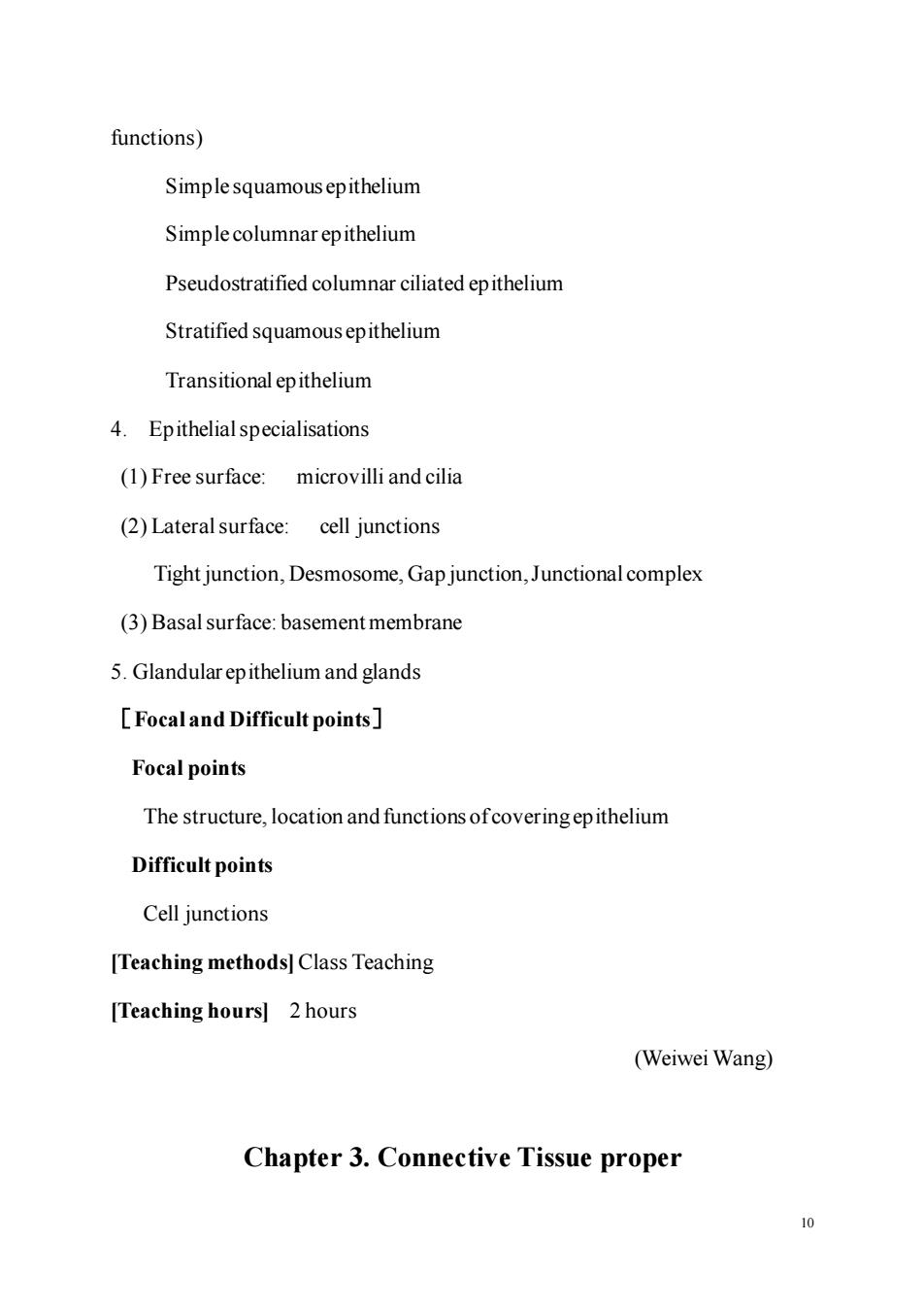
functions) Simple squamous epithelium Simple columnar epithelium Pseudostratified columnar ciliated epithelium Stratified squamous epithelium Transitional epithelium 4.Epithelial specialisations (1)Free surface:microvilli and cilia (2)Lateral surface: cell junctions Tight junction,Desmosome,Gap junction,Junctional complex (3)Basal surface:basement membrane 5.Glandular epithelium and glands Focaland Difficult points] Focal points The structure,location and functions ofcoveringepithelium Difficult points Cell junctions [Teaching methods]Class Teaching [Teaching hours]2 hours (Weiwei Wang) Chapter 3.Connective Tissue proper
10 functions) Simple squamous epithelium Simple columnar epithelium Pseudostratified columnar ciliated epithelium Stratified squamous epithelium Transitional epithelium 4. Epithelial specialisations (1) Free surface: microvilli and cilia (2) Lateral surface: cell junctions Tight junction, Desmosome, Gap junction, Junctional complex (3) Basal surface: basement membrane 5. Glandular epithelium and glands [Focal and Difficult points] Focal points The structure, location and functions of covering epithelium Difficult points Cell junctions [Teaching methods] Class Teaching [Teaching hours] 2 hours (Weiwei Wang) Chapter 3. Connective Tissue proper